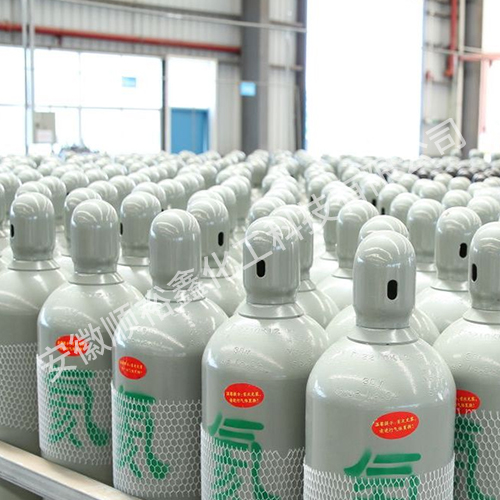Helium
2024/6/6
![]()
Chemical Formula:He
Helium technical indicators:
|
Components/Impurities |
Pure helium/4.0N |
High purity helium/5.0N |
Ultra pure helium/6.0N |
|
Helium content |
0.9999 | 0.99999 | 0.999999 |
|
Neon |
≤40ppm | ≤4ppm | ≤1ppm |
| H2 | ≤7ppm | ≤1ppm | ≤0.1ppm |
| O2+Ar | ≤5ppm | ≤1ppm | ≤0.2ppm |
| N2 | ≤25ppm | ≤2ppm | ≤0.5ppm |
| CO | ≤1ppm | ≤0.5ppm | ≤0.1ppm |
| CO2 | ≤1ppm | ≤0.5ppm | ≤0.1ppm |
| THC | ≤1ppm | ≤0.5ppm | ≤0.1ppm |
| H2O | ≤20ppm | ≤3ppm | ≤0.2ppm |
Types of helium packaging:
Control tanker
(TT)
Types of steel cylinders
Pressure
Gas volume
Net weight of gas
50L steel cylinder
19.5±0.5MPa
10000L
1.65kg
40L steel cylinder
14.5±0.5MPa
5400L
0.975kg
10L steel cylinder
10MPa
1000L
0.165kg
4L steel cylinder
10MPa
400L
0.06kg
20MPa
≈5000m³
≈825kg
Color,odor,and toxicity:Helium is a colorless,odorless,and non-toxic gas.It is not easily soluble in water,but can react with certain substances under certain conditions.
Density and stability:Helium has a low density of approximately 0.1786kg/m3,making it the gas with the lowest density known besides hydrogen.Due to its much lower density than air(which has a density of 1.29kg/cubic meter),helium is an extremely light gas at room temperature and pressure.Helium has very stable chemical properties and is not easily reactive with other substances,making it an inert gas.
Liquefaction characteristics:Helium is a gas that is difficult to liquefy,but can liquefy at 2.25 atmospheres,and the liquefaction temperature can be reduced to below-270.98℃.Liquid helium has very low surface tension,strong thermal conductivity,and almost no viscosity.
Thermal conductivity:Helium gas has high thermal conductivity due to its small intermolecular interactions,allowing for rapid heat transfer.
Sound propagation speed:The sound propagation speed of helium is about three times that of air,so people who inhale helium will speak at a higher frequency.This phenomenon is often used in entertainment to create humorous effects.
2、Source of helium gas
1.Mantle degassing:Primitive helium in the Earth's mantle can be released into shallow sedimentary reservoirs through degassing.
2.Radioactive element decay:Radioactive elements such as uranium and thorium decay in rocks and minerals to produce helium gas,which is the main source of crustal helium.
3.Helium in the atmosphere:Helium in the atmosphere mainly comes from helium released by solid Earth degassing processes,such as volcanic eruptions,fracture magma degassing,and rock weathering.
The main method for preparing helium gas is through natural gas separation and purification.In industry,the condensation method is used to extract helium from natural gas,including pre-treatment and purification of natural gas,processing of crude helium,and refining of helium.Ultimately,99.99%purity helium can be produced.
3、Main purpose
Helium is widely used in military,scientific research,petrochemical,refrigeration,medical,semiconductor,pipeline leak detection,superconducting experiments,metal manufacturing,deep-sea diving,high-precision welding,optoelectronic product production,etc.
(1) Low temperature cooling source:Utilizing the low boiling point of liquid helium at-268.9℃,liquid helium can be used for ultra-low temperature cooling.Ultra low temperature cooling technology has a wide range of applications in superconducting technology and other fields.Superconducting materials need to exhibit superconducting properties at low temperatures(around 100K),and in most cases,only liquid helium can achieve such extremely low temperatures relatively easily.Superconducting technology has significant applications in maglev trains in the transportation industry and magnetic resonance imaging equipment in the medical field.
(2) Balloon inflation:Due to the much lower density of helium compared to air(1.29kg/m3 for air and 0.1786kg/m3 for helium)and its extremely inactive chemical properties,it is safer than hydrogen(which can burn in air and may cause explosions).Helium is commonly used as the inflation gas in spacecraft or advertising balloons.
(3) Inspection and analysis:The superconducting magnet of the commonly used nuclear magnetic resonance analyzer in instrument analysis needs to be cooled by liquid helium.In gas chromatography analysis,helium is often used as a carrier gas,taking advantage of its good permeability and non flammability.Helium is also used for vacuum leak detection,such as helium mass spectrometer leak detectors.
(4) Protective gas:Utilizing the inert chemical properties of helium,helium is commonly used as a protective gas for welding metals such as magnesium,zirconium,aluminum,and titanium.
(5) Semiconductor industry:The semiconductor industry must use helium gas.
(6) In other aspects,helium can be used as a pressurized gas for transporting liquid propellants such as hydrogen and liquid oxygen in high vacuum devices and nuclear reactors on rockets and spacecraft.Helium is also used as a cleaning agent for atomic reactors,in mixed gases for respiration in the field of ocean development,and as a filling gas for gas thermometers.
Anhui Shunyuxin Chemical Technology Co.,Ltd. Copyright disclaimer

